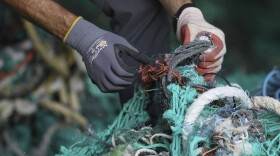For centuries, native Hawaiians fed themselves by developing sophisticated systems of fishponds and irrigated taro patches. But societal changes disrupted their connection to traditional food sources, leading to high health risks for diabetes, obesity, and other diseases. Now a community intervention is underway in Waim?nalo using backyard aquaponics.
Waim?nalo resident Shelly Ortiz gives me a tour of her backyard aquaponics system. It's got two levels of plastic tubs connected by PVC pipes. On top are three grow beds filled with black cinder and starter veggies and below is the fishtank filled with baby tilapia.
“We feed them, and then they poop. And the poop gets uptake into grow beds,” said Ortiz. “And all that good nitrates that the fish provide will give all the nutrients into the plants to help them grow.”
The water from the plants flows back down to the fish tank, and the cycle repeats. If you asked Ortiz six months ago how this all worked, she probably couldn’t tell you. She just wrapped up a crash course in aquaponics, where she even got to build her own system.

“I would love to see it in every Hawaiian family’s backyard,” said ‘Ilima Ho-Lastimosa with the MALAMA Study, a three-year research project that is evaluating the impact of aquaponics on participants' health.
Ho-Lastimosa has been a aquaponics champion in her hometown of Waim?nalo for more than a decade. She touts the economic and health benefits that result when households produce their own fish.
“I remember when we started doing it back in 2010, people thought we were crazy,” said Ho-Lastimosa. “They were like, 'It’s not gonna work.' But for us, we saw it as the ahupua’a.”
Ahupua’a is a symbiotic system of food production from land to sea, or in this case veggies to fish. Ho-Lastimosa teamed up with organic farmer Ted Radovich and public health scientist Jane Chung-Do to launch the MALAMA Study.
“So we are measuring things like A1C (a diabetes blood test), BMI (body mass index), cholesterol, and things like that,” said Chung-Do. “But I’m also as interested in people’s mental health, looking at their feelings of community cohesion, looking at their cultural identity, and just really looking at health in a holistic way.”
Her hypothesis is that having a backyard aquaponics system, and learning to build and maintain it with other community members, contribute to long-term health improvement.
Ortiz is hopeful. “That I can stop that cycle, stop that cycle of getting the diabetes, high blood pressure, the cancer...all of the problems that is prevalent in my ‘ohana,” said Ortiz.
It’s too early to say if all her work is improving her health, but she’s in it for the long haul. She says all she has to do is keep the pump flowing and the electricity on.
“We?ve got electricity," said Ortiz. "We’re good to go.”








